Introduction
The elegant, wildly-fast cheetah (Acinonyx jubatus) is a large carnivorous cat found across Africa, with a small population of Asiatic cheetahs in Iran. With just over 7,000 left in the wild1https://www.iucnredlist.org/species/219/247393967#population, they are a critically endangered species and Africa’s most endangered big cat.2https://cheetah.org/learn/about-cheetahs/
Whereas they once used to roam across all of Africa and India (and, in pre-historic times, Europe), they are now mainly only in eastern and southern Africa. According to the IUCN Red List of Threatened Species, about 2,100 cheetahs live in East Africa, and 17 of them are found in Kidepo Valley National Park in Uganda.1https://www.iucnredlist.org/species/219/247393967#population There have also been several sightings in the north of Murchison Falls National Park3https://ugandawildlife.org/animals/cheetah/ and some sources say that, thanks to conservation efforts, their population is slowly increasing in Uganda.4https://destinationuganda.com/animals/cheetah/ However, this has yet to be confirmed and globally the cheetah’s numbers are very much in decline.1https://www.iucnredlist.org/species/219/247393967#population Cheetahs can live up to 14 years in the wild.5https://www.nationalgeographic.com/animals/mammals/facts/cheetah
Fascinating facts
Catch me if you can!
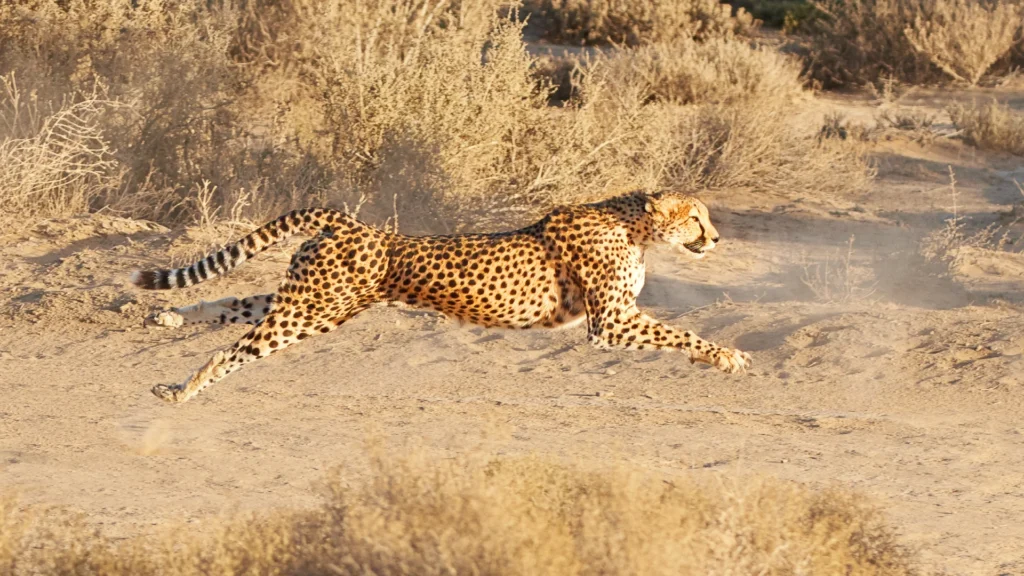
Cheetahs are the fastest land animal on Earth. They can reach blistering speeds of 71 miles per hour (114km/hr) in just three seconds.6https://www.britannica.com/animal/cheetah-mammal They regularly reach 55 mph (90km/hr) when chasing prey. By comparison, the average human sprinting speed is 14 miles per hour (24 km/hr).7https://marathonhandbook.com/average-human-sprint-speed/ Coupled with their nimble ability to quickly change direction, speed allows cheetahs to hunt gazelles that are twisting and turning as they try to escape.
Cheetahs have evolved to be much leaner and lightweight than the other big cats, so speed triumphs over strength. This means if they are confronted by a threat, they will wisely run away instead of fight.2https://ugandawildlife.org/animals/cheetah/ Adult males weigh only 6.5 to 7 stone (41 to 45kg) on average, and females 5.6 to 5.8 stone (36 to 37kg).
Band of brothers

Males often prowl around in small groups of two or three (though some are solitary). They are usually brothers but, in the Serengeti, a study showed 30 per cent were unrelated. This way they can protect their territory against rival gangs, have better territory and have more success hunting their prey. They cooperate in everything, except breeding.8https://africageographic.com/stories/the-power-of-unity-cheetah-coalition-in-maasai-mara/
Cheetah cubs are born helpless

After mating, the female is pregnant for about three months before giving birth in a secluded spot, to between one to six cubs.2https://cheetah.org/learn/about-cheetahs/ The babies are born blind and defenceless. Their mother lovingly purrs and grooms them, keeping them warm.
Cheetah cubs’ poor chance of survival
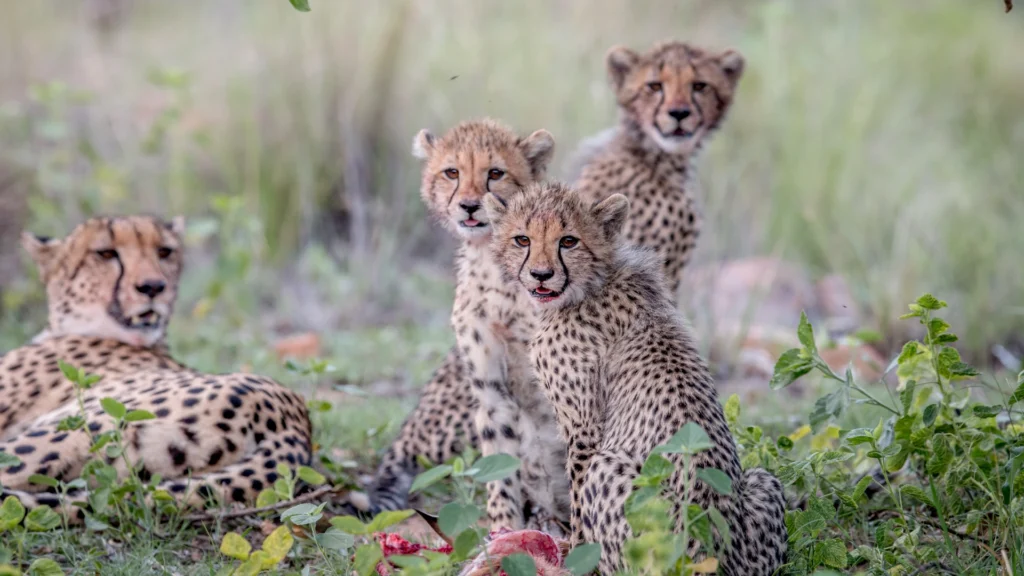
About three quarters of cheetah cubs born, fall prey to mainly, lions and hyenas before they leave the lair at two months old. Their mother may have left them to hunt but even if she were near, she could not fight off these large predators. She will move nest several times to try and avoid detection by predators. Of the remaining survivors who leave the nest, a startling four-fifths of cubs are killed, again largely by predation.9https://zslpublications.onlinelibrary.wiley.com/doi/10.1111/j.1469-7998.1994.tb04855.x
Mum’s the word
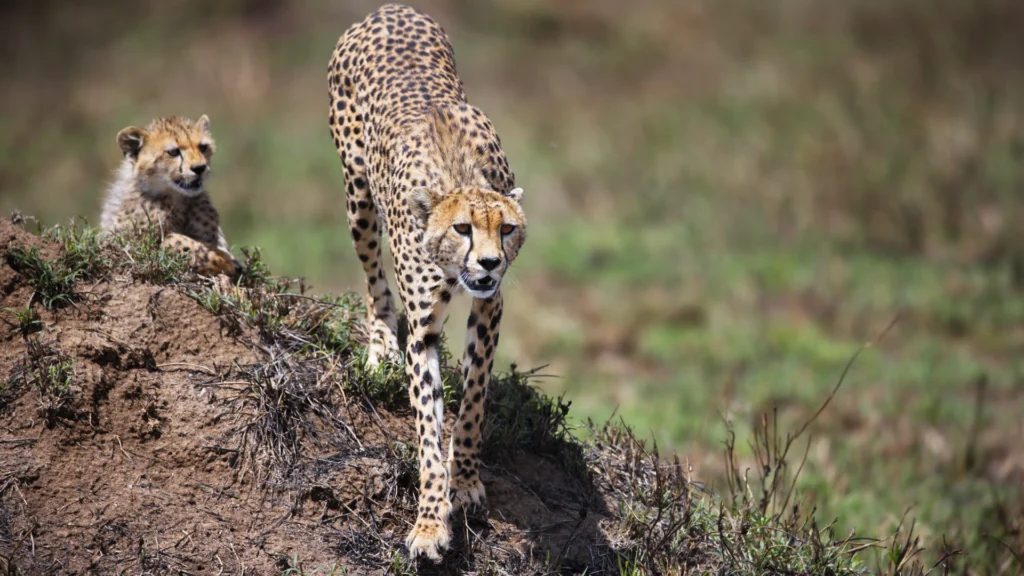
The cubs that do survive, stay with their mum for about 18 months. They are weaned at six to eight weeks old, when they leave the lair and stay close to her from then on. However, she has to leave her cubs to hunt and their only defence is their long silver-grey fur running along their back, which helps their camouflage but also mimics the fur of the honey badger – a very aggressive creature that most predators don’t want to mess with!2https://cheetah.org/learn/about-cheetahs/
At about five months old, the cubs often play – chasing, stalking and wrestling each other, honing their hunting skills. The mother cheetah will bring live injured prey to her cubs when they are six months old, so they can practice how to kill. From eight months the cubs will hunt but they are not good at it, they only kill about 10 per cent of their prey. At 15 to 24 months the cubs leave their mother but may stay together for several more months.2https://cheetah.org/learn/about-cheetahs/
Cheetahs have natural running shoes
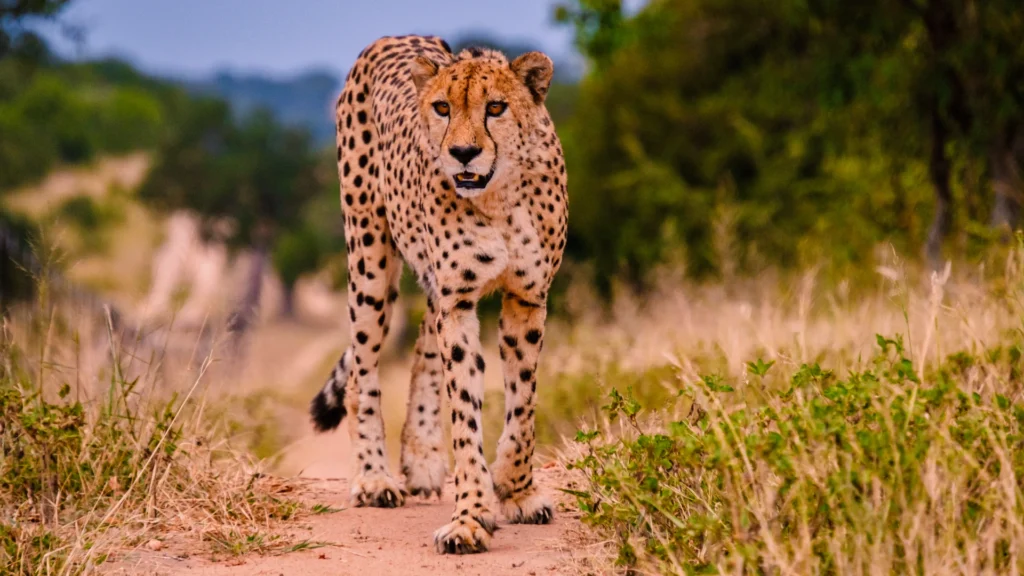
Unlike the paws of lions and leopards, a cheetah’s are harder and less rounded, giving them better traction on the ground. Their blunt claws only semi-retract and grip the ground like spikes in running shoes to help them reach super speeds.
Cheetahs have about 2,000 spots
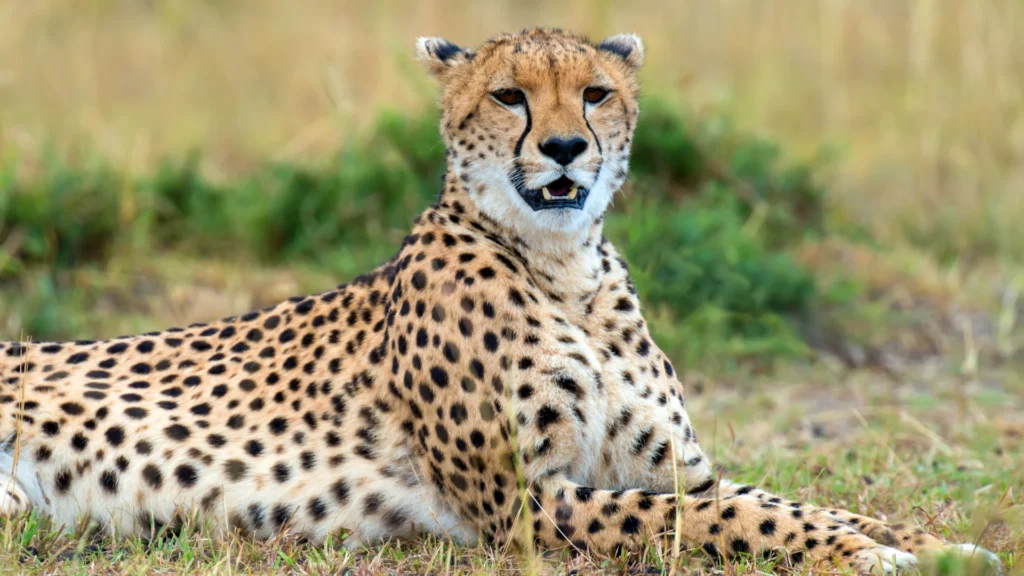
Cheetahs are born with their spots, which are as unique as a human fingerprint, and they stay the same throughout their life. A cheetah’s spots are great camouflage – so they can hide from predators and sneak up on their prey without being seen. In fact, cheetahs are named after their spots. ‘Chita’ means ‘spotted one’ in Hindi.
Cheetahs only hunt during the day
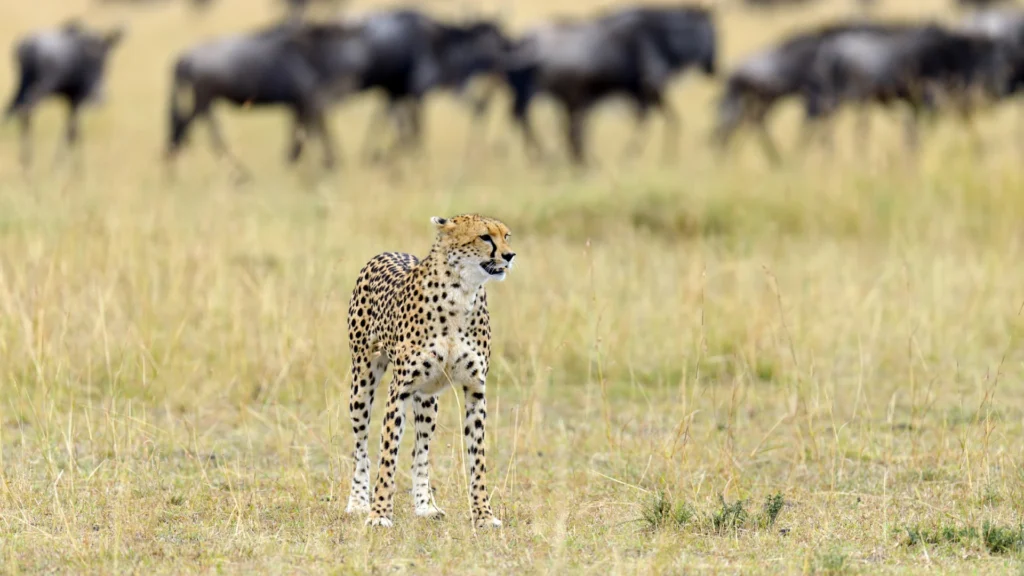
Unlike their lion and leopard cousins, cheetahs prefer to hunt during the day – usually early in the morning and in the late afternoon. During the middle of the day, when the temperature is at its highest, cheetahs like to relax in the shade of a tree.
Threats to cheetahs
Hunting
The hunting of cheetahs for their beautiful fur, and for the illegal pet trade, is a major threat to their survival. Most of the illegal cheetah trafficking is between East Africa, where Uganda is located, and the Arabian Peninsula.10https://cheetah.org/wp-content/uploads/2019/08/CCFFactSheets2019_IWT.pdf Saudi Arabia is responsible for over 50 per cent of recorded illegal cheetah trade incidents in the Middle East.11https://www.ncbi.nlm.nih.gov/pmc/articles/PMC7893423/ Because the only populations of wild cheetahs in Uganda are found in its protected national parks, most of the trafficking occurs in Ethiopia, Kenya and Somalia. According to the Cheetah Conservation Fund, approximately 300 cheetahs, mostly cubs, are smuggled out of East Africa every year.10https://cheetah.org/wp-content/uploads/2019/08/CCFFactSheets2019_IWT.pdf This emphasises the importance of maintaining protection for cheetahs in Uganda so that those that are left do not fall victim to this cruel trade.
Habitat loss
With the growing population of Uganda, more and more of the cheetah’s habitat is being lost to human development. Grasslands are being converted into farmland, are being fragmented by roads, and are destroyed to build human settlements.
As a result of Uganda’s population growth, increased urbanisation, and an increased income for wealthier Ugandans, the demand for animal products is likely to dramatically rise in the coming years. The FAO estimates that by 2050, the demand for meat and milk products in Uganda will more than double and “the production of all types of meat and that of milk will increase by 164 and 41 per cent, respectively.”12https://www.fao.org/3/ca7009en/CA7009EN.pdf
To produce these animal products, land that was once beautiful and iconic savannah and forest – and a home to Uganda’s majestic wildlife – will be turned into farmland. The conversion of land to agriculture will strip the wildlife of its natural habitat and put increasing pressure upon the land to support life. In the last one hundred years, Uganda has lost 42 per cent of its forest cover, decreasing from 54 per cent to 12 per cent in 2017.13https://illuminem.com/illuminemvoices/deforestation-in-uganda-causes-and-recommendations Encroachment into Queen Elizabeth National Park by illegal cattle ranchers is common14https://conbio.onlinelibrary.wiley.com/doi/abs/10.1111/cobi.12538?campaign=woletoc and the National State of the Environment Report for Uganda 2014, attributes this to “the increasing demand of land for agriculture and fuel wood by the rapidly increasing population growth.”15https://nema.go.ug/sites/all/themes/nema/docs/FINAL%20NSOER%202014.pdf
Of course, a growing population needs food but it would be much more sustainable to meet these needs through the growing of crops instead of farming animals. Animal foods require by far the most land and resources – this is because land is not only used for grazing but also for growing food for the animals. The more animal-based foods we eat, the more endangered our forests become. However, crops are a far more efficient way to feed the growing population and use less land and other natural resources. A vegan diet is associated with only half the cropland demand, grazing intensity and overall biomass harvest of meat-based diets16https://www.nature.com/articles/ncomms11382 so switching to a vegan diet would have a phenomenal impact on reducing deforestation and land degradation in Uganda.
In addition, poor land management is devastating the ecosystem from top to bottom. For example, thorn bushes used to be kept at a low level by elephants and rhinos but now, because of their absence, are overgrowing the savannah and replacing grassland.17https://cheetah.org/ccf-blog/conservation/climate-change-and-cheetahs/ Cheetahs rely on being able to roam large areas of land for their survival but this is becoming increasingly impossible. Over three-quarters of the known cheetah range is on unprotected lands, which are being lost bit by bit, leaving the cheetah with nowhere to go and nothing to hunt.18https://www.awf.org/wildlife-conservation/cheetah
Human-wildlife conflict
The more humans encroach into the cheetah’s territory, the more encounters there are between the two. Over 90 per cent of Africa’s cheetahs live outside of protected zones and more than 75 per cent of them live on rural farmlands alongside human communities, where cows, sheep and goats are being farmed.19https://cheetah.org/learn/human-wildlife-conflict/
With these farms being built on the cheetah’s natural hunting ground, and with the displacement of their natural prey, cheetahs occasionally prey on the farmed animals. Because of this, cheetahs are viewed as a pest and a threat by the local community and are hunted down and killed in an abhorrent act of revenge. During the 1980s in Namibia, for example, game and livestock farmers slashed the cheetah population in half.19https://cheetah.org/learn/human-wildlife-conflict/
References
References
- 1
- 2
- 3
- 4
- 5
- 6
- 7
- 8
- 9
- 10
- 11
- 12
- 13
- 14
- 15
- 16
- 17
- 18
- 19

